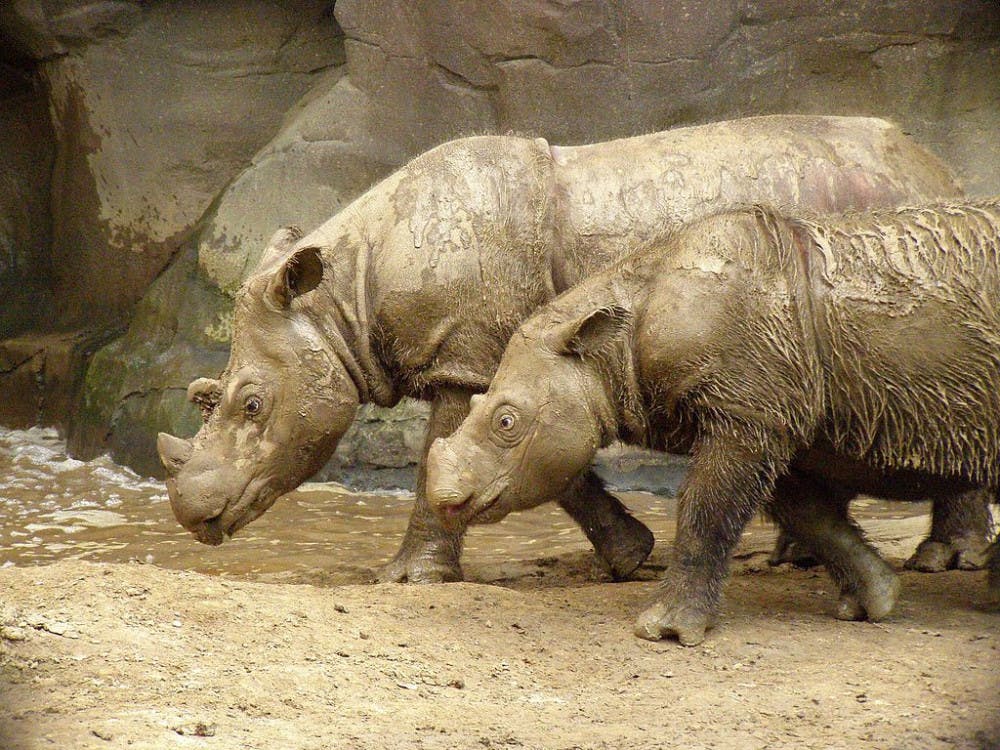Sumatran rhinoceroses once inhabited a vast expanse of land in mainland East Asia, according to a new study by University professors. Today, they are located primarily in Sumatra, Indonesia.
Due to hunting, expansion of the human population and increased agriculture, the area occupied by these rhinos has shrunk significantly ever since the start of human development in the first millennium B.C. Now, hunting and agriculture practices still continue to drive down the number of Sumatran rhinos, raising concerns that they will become extinct.
Previous research suggested that “the Sumatran rhino was doomed to die out, and that you could see it in the DNA sequence,” said Brian Lander, assistant professor of history and environment and society.
But DNA does not provide sufficient ability to predict the extinction of living rhinos, Lander said. Current Sumatran rhinos have been separated from the rhinos that existed on mainland China 9,000 years ago, he said. “So their DNA does not tell us anything about the whole population (of those in Indonesia),” he added.
According to Lander, there is no question that the primary cause of the Sumatran rhino’s impending extinction is humans and not nature. For scientists to suggest otherwise is “very problematic,” he added.
The Sumatran rhino’s ecosystem is affected by the increasing human population and its consequent need for increased agricultural land, said Bathsheba Demuth, assistant professor of history and environment and society.
The issue is that many domesticated species, such as cattle, survive in the same environments that rhinos do, said Tyler Kartzinel, assistant professor of ecology and evolutionary biology and of environment and society. Humans concentrate in these areas where their domesticated animals can live, and impinge on the ecosystems of native animals.
Populations of larger animals are more likely to end up endangered as a result of humans, Kartzinel said. Some large animals are good food sources for humans yet reproduce slowly and end up becoming threatened, he added.
“Essentially, it’s a combination of humans turning (the Sumatran rhino’s) natural habitat into farmland and hunting them for their horns,” Lander said. “That’s the whole cause. If there were no humans in the region, there would be plenty of rhinos,” he added.
“The only way you can really reverse it at the local level is to maintain ecosystems in their natural form,” he added.
The question essentially comes down to choice and whether humanity in different ecosystems values the animals dead or alive, Demuth said. Hunting pressure and agricultural land expansion are human choices; therefore, it is a human choice to maintain the habitats of creatures such as the Sumatran rhino, she added.
The problem is that people of East Asia regard rhino horns as a powerful medicine, which creates a strong economic incentive to poach these animals, Lander said. Poachers are even hunting rhinos in Africa to sell their horns in the East Asian market, he said.
“The horns of these animals are extremely valuable on the international market for people in countries where they don’t have a lot of economic options” for health care, Demuth said. “There is a situation of racial and economic inequality that’s at play,” she added.
“It is so difficult to stop both the processes of land conversion and illegal hunting,” so it is very likely the Sumatran rhino will be driven to extinction, Lander said.
The factors threatening the Sumatran rhinos are the same ones that are affecting many animals, Lander said. “If you look at it in the larger historical picture, there is nothing particularly unusual about the situation,” he added.
People need to reconsider their interactions with ecosystems by watching fuel usage and creating access to goods and services in an environmentally sustainable way, Demuth said. Humans should act on another set of cultural values to make that happen, she added. “It is going to take some work and deliberate decision-making to reimagine what our relationship with consumption looks like,” she added.
“But I think this article shows quite convincingly that this is a much longer process,” Demuth said. “It’s not just this particular modern moment, but something that has much deeper roots,” she added.
Rewilding and restoration are two attempts to revitalize nature that could possibly save the Sumatran rhino, Kartzinel said. Rewilding is the practice of placing animals in a new area, such as the Great Plains of the United States, or even Siberia, while restoration is the practice of reintroducing a species of animal that has become nonexistent in a particular place. The Sumatran rhino could be added back to its previous native location of mainland China, he added.
These may be strange and quite controversial ideas, Kartzinel said. But this research may reveal how we may be able to reverse the ways humans have damaged animal populations, he added.





